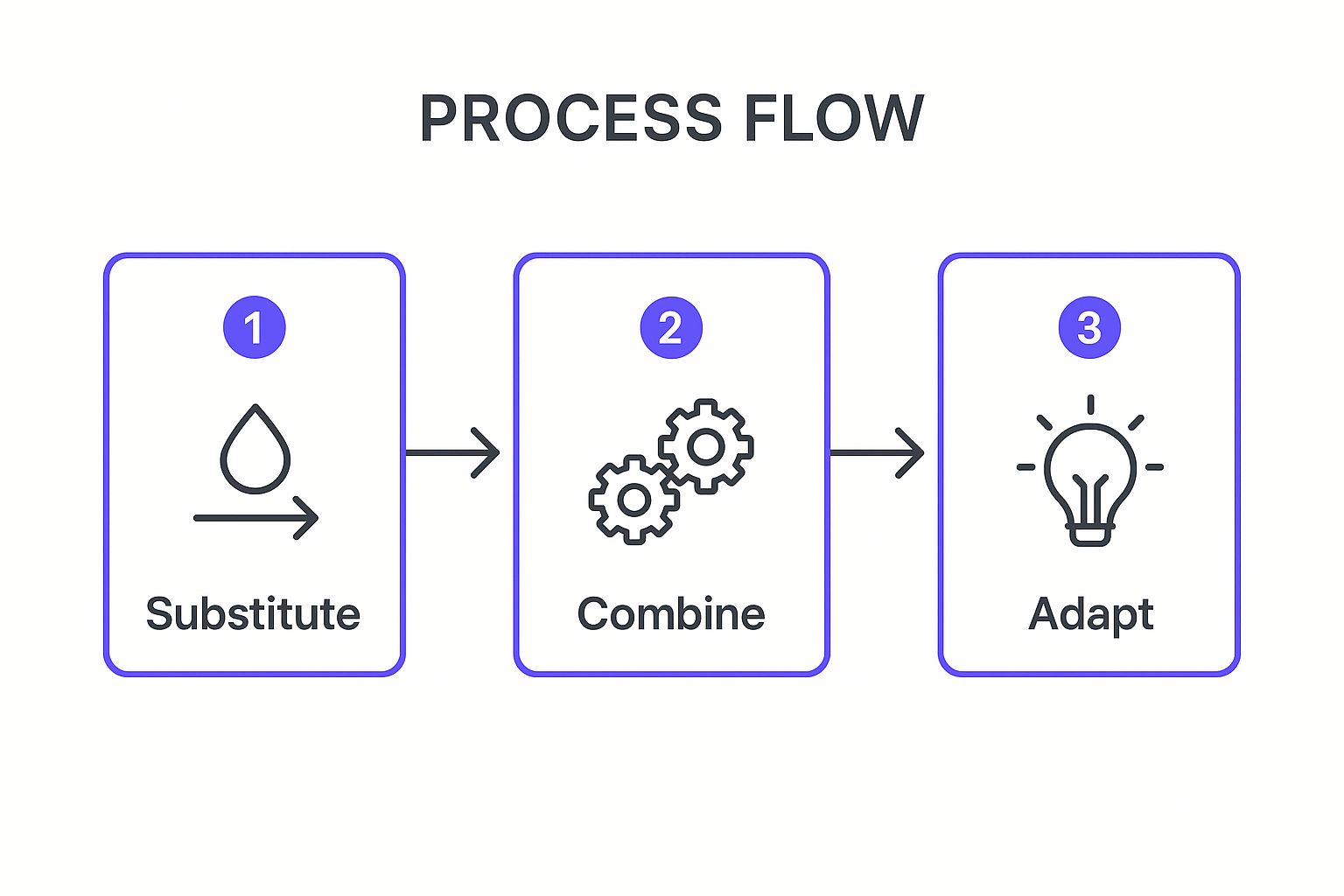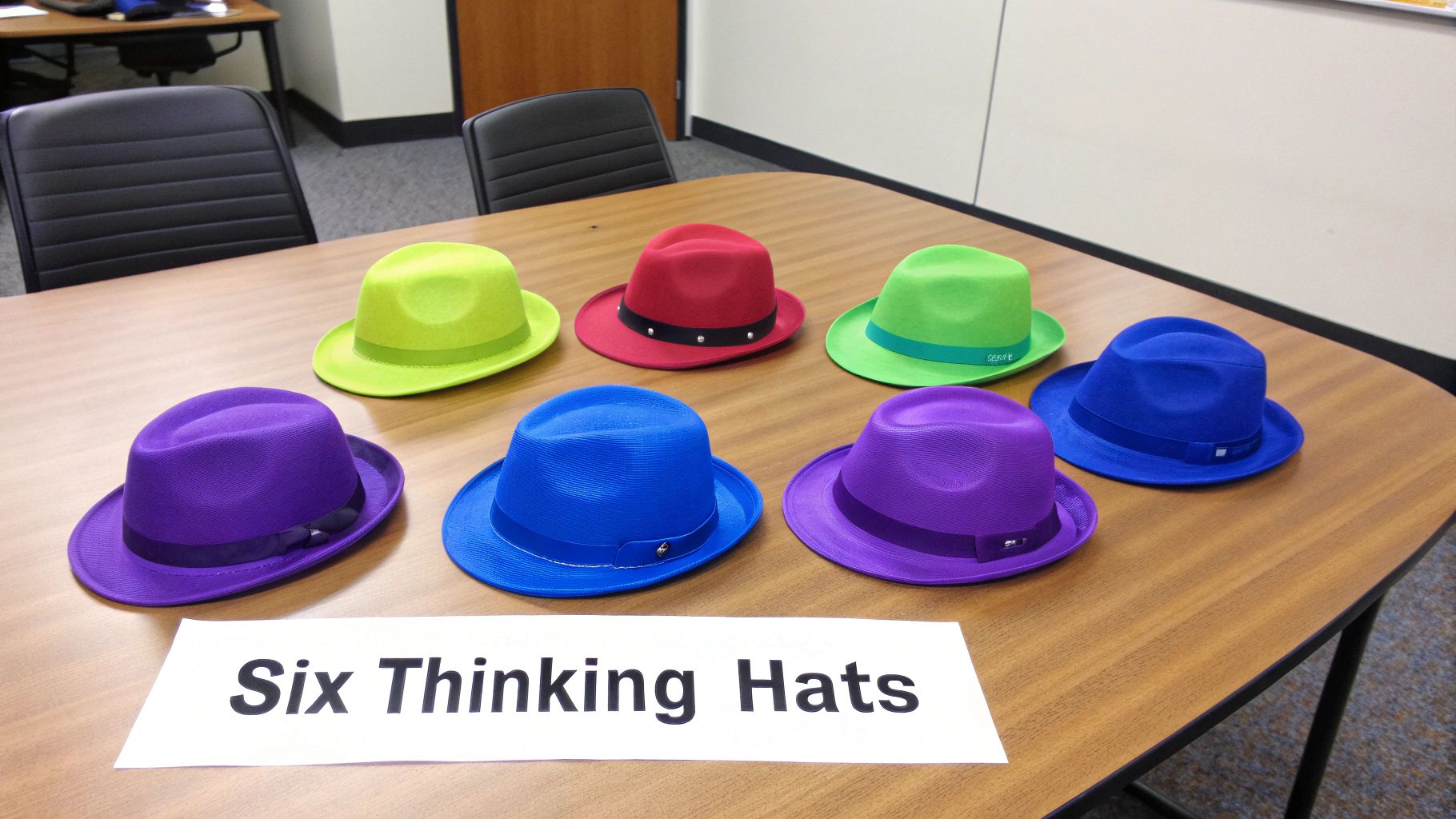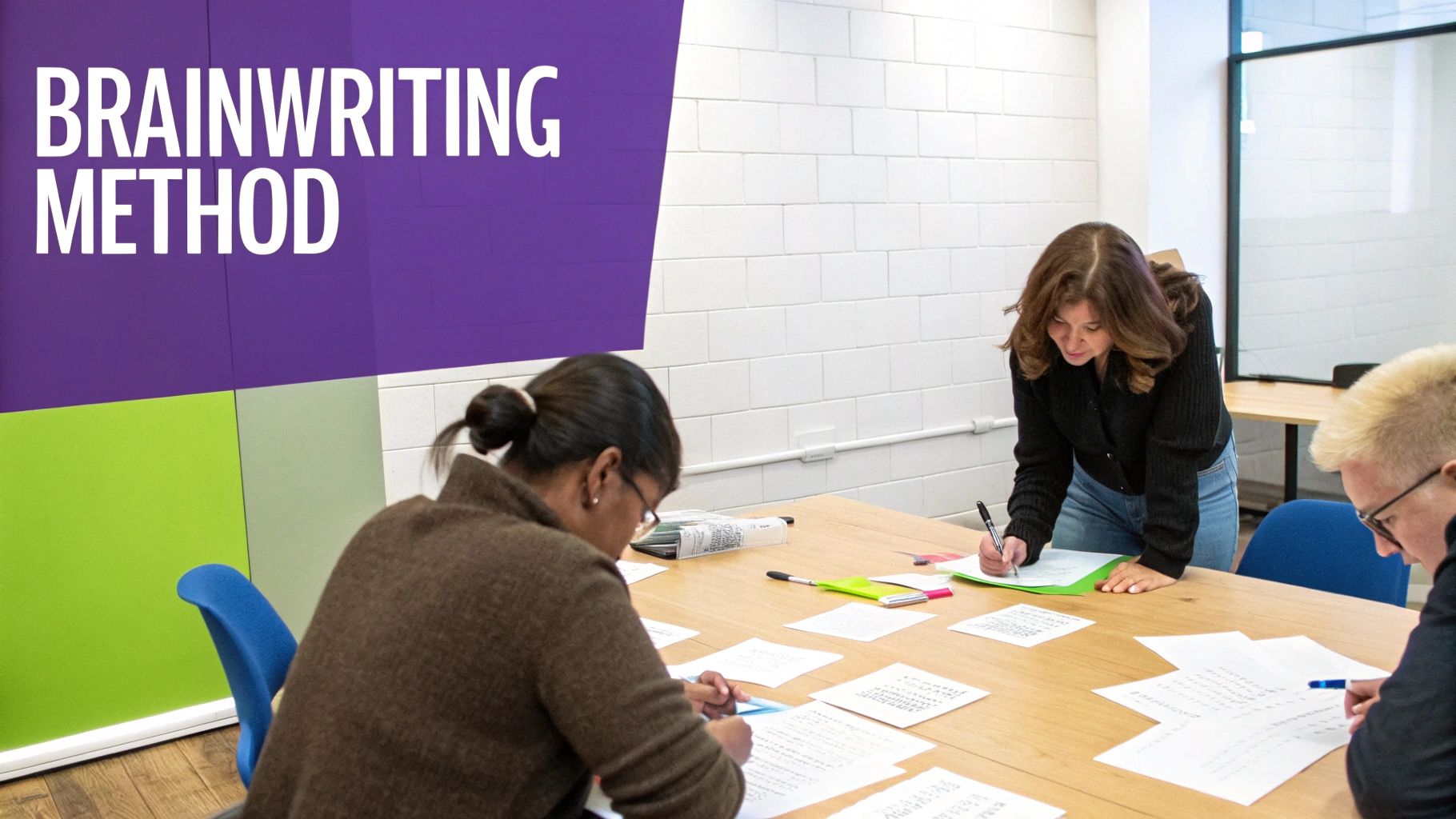Igniting Innovation: A Deep Dive into Structured Brainstorming
Generating innovative ideas is crucial for success. Unstructured brainstorming, however, can be inefficient. Structured brainstorming methods offer a solution, providing frameworks that channel creativity and encourage productive collaboration. This listicle explores seven powerful methods, offering step-by-step instructions, real-world use cases, and tips specifically for remote teams. Learn how to implement techniques like Mind Mapping, SCAMPER, Six Thinking Hats, and more to unlock your team's full potential.
These techniques are especially valuable for distributed teams who need to maximize engagement and collaboration, even from afar. To foster a collaborative environment for your remote team, consider exploring some creative virtual team meeting ideas to enhance your brainstorming sessions.
This guide provides practical implementation details, ensuring these structured brainstorming methods become valuable tools in your innovation arsenal. Whether you're a product manager, a student entrepreneur, or part of a virtual team, these methods will transform your brainstorming sessions, leading to more impactful ideas and better results.
1. Mind Mapping
Mind mapping is a powerful structured brainstorming method that visually organizes ideas. It uses a diagram resembling a tree, with the central topic at the root and related ideas branching outwards. This structure encourages both logical and creative thinking, connecting concepts in a non-linear, visual way. This approach can be particularly useful for understanding key concepts and their relationships within a given topic. Understanding key concepts is crucial for effectively using structured brainstorming; for example, exploring AI Chatbot Terminology can enhance your ability to leverage AI tools in this process.

How Mind Mapping Works
Start by placing the central topic in the middle of your page. Then, draw branches radiating outwards for main ideas related to the central topic. From these main branches, draw smaller branches for subtopics, and so on. This creates a hierarchical structure, visually representing the relationships between ideas.
Real-World Examples
Mind mapping has proven effective across various industries. The BBC uses it for program development and content planning. Boeing has employed mind mapping for brainstorming in aircraft design. Educational institutions use it for curriculum planning and lesson development. These examples highlight its versatility and adaptability to different brainstorming needs.
Tips for Effective Mind Mapping
- Start with a Clear Central Topic: A well-defined central topic ensures the mind map stays focused.
- Use Colors and Visuals: Different colors for branches represent different themes, and incorporating images enhances memorability.
- Keep it Concise: Use short words and phrases to capture ideas quickly.
- Prioritize Idea Generation: Focus on generating ideas initially; organize and refine the map later.
- Review and Refine: After the initial brainstorming, review the mind map to identify key insights and connections.
When to Use Mind Mapping
Mind mapping is particularly beneficial for:
- Generating new ideas: Its visual nature sparks creativity and helps uncover unexpected connections.
- Organizing complex information: It clarifies relationships between different concepts.
- Problem-solving: Breaking down problems into smaller parts simplifies finding solutions.
- Project planning: It provides a clear overview of project scope and tasks.
Mind mapping, popularized by Tony Buzan and supported by software like MindMeister and XMind, is a valuable tool for structured brainstorming. Its visual and hierarchical approach encourages idea generation, organization, and analysis. Learn more about mind mapping to explore its potential further. This method is particularly well-suited for remote teams, providing a shared visual space for collaborative brainstorming and idea development.
2. SCAMPER Method
The SCAMPER method is a structured brainstorming technique that uses a checklist of idea-spurring questions to trigger innovative solutions. SCAMPER, an acronym for Substitute, Combine, Adapt, Modify/Magnify, Put to other uses, Eliminate, and Reverse/Rearrange, provides a framework for transforming existing ideas or addressing problems creatively. Each letter prompts a different angle for exploring possibilities and generating novel solutions. This method encourages structured and targeted thinking, leading to more effective brainstorming sessions. Understanding key concepts is crucial for leveraging structured brainstorming methods like SCAMPER; exploring resources on innovation frameworks can further enhance your brainstorming capabilities.
How SCAMPER Works
SCAMPER guides you through a series of questions related to each letter of the acronym. For "Substitute," you might ask, "What can be substituted in this product or process?" For "Combine," you could explore merging existing ideas or features. Working through each prompt systematically helps uncover hidden opportunities and innovative solutions. This structured approach ensures a comprehensive exploration of possibilities.

The infographic above illustrates a simplified SCAMPER process flow, highlighting the sequential relationship between substituting, combining, and adapting elements within a product or process. By following these steps, brainstorming sessions can yield innovative and practical solutions.
Real-World Examples
3M uses SCAMPER for product development and improvement initiatives, generating novel ideas and enhancing existing products. IDEO, a renowned design firm, incorporates SCAMPER techniques in their design thinking workshops. Even McDonald's leveraged SCAMPER-like thinking to develop the McFlurry by adapting milkshake preparation methods. These examples demonstrate SCAMPER's versatility across different industries and applications.
Tips for Effective SCAMPER
- Work through each letter systematically: Spending adequate time on each category ensures thorough exploration.
- Use specific, targeted questions: Framing questions relevant to your challenge yields focused results.
- Combine SCAMPER with other brainstorming methods: Integrating SCAMPER with other techniques enhances idea generation.
- Document all ideas: Capturing even seemingly impractical ideas can spark further innovation.
- Practice with familiar objects: Applying SCAMPER to everyday items builds proficiency before tackling complex problems.
When to Use SCAMPER
SCAMPER is particularly beneficial for:
- Product development: Generating new product ideas or improving existing ones.
- Process improvement: Identifying opportunities to streamline and optimize processes.
- Problem-solving: Finding creative solutions to complex challenges.
- Innovation workshops: Facilitating structured and engaging brainstorming sessions.
Developed by Bob Eberle based on Alex Faickney Osborn's checklist, SCAMPER provides a powerful framework for structured brainstorming. Its step-by-step process, combined with its versatile applications, makes it a valuable tool for individuals and teams seeking innovative solutions. This method is particularly well-suited for remote teams, providing a structured framework for virtual brainstorming sessions and fostering creative problem-solving in distributed environments.
3. Six Thinking Hats
Six Thinking Hats is a structured brainstorming method emphasizing parallel thinking. It uses different colored “hats” to represent distinct thinking modes, allowing groups to focus on one aspect at a time. This systematic approach promotes a comprehensive understanding of problems and potential solutions by ensuring a structured exploration of diverse perspectives. This structured approach is especially valuable for structured brainstorming methods, enhancing idea generation and decision-making processes.

How Six Thinking Hats Works
Each hat signifies a specific perspective: White (facts and information), Red (intuition and feelings), Black (critical judgment and risks), Yellow (optimism and benefits), Green (creativity and new ideas), and Blue (process overview and control). Participants metaphorically “wear” these hats to explore a topic from multiple angles. This structured approach ensures balanced thinking and avoids the chaotic nature of traditional brainstorming sessions.
Real-World Examples
Many organizations have successfully implemented Six Thinking Hats. IBM used it for strategic planning, seeing improvements in decision-making efficiency. Singapore's government agencies employ it for policy development, facilitating more holistic approaches. Motorola integrated this technique into product development processes, resulting in more innovative product designs.
Tips for Effective Use
- Introduce the method clearly: Begin with a brief overview of Six Thinking Hats and its benefits.
- Practice with simple topics: Start with easier subjects to familiarize the team with the process.
- Ensure understanding: Clarify each hat's focus to prevent confusion during discussions.
- Skilled facilitator: A facilitator can guide the team through the different thinking modes and ensure effective transitions.
- Adequate time: Allow sufficient time for each hat, particularly Green (creative thinking).
- Document insights: Record key points from each perspective for later review and analysis.
When to Use Six Thinking Hats
Six Thinking Hats is particularly effective when:
- Evaluating complex problems: It provides a structured framework for analyzing intricate issues.
- Making critical decisions: It ensures all perspectives are considered before a decision is made.
- Improving communication: It establishes a common language for expressing different viewpoints.
- Enhancing team collaboration: It fosters structured dialogue and encourages participation from all members.
Six Thinking Hats, popularized by Edward de Bono, offers a valuable framework for structured brainstorming. Its use of parallel thinking enhances communication, encourages diverse perspectives, and ultimately leads to more informed decisions. Learn more about Six Thinking Hats and its applications for creative thinking exercises for groups. This method is particularly well-suited for remote teams as it provides a structured and focused approach for virtual brainstorming sessions.
4. Nominal Group Technique (NGT)
Nominal Group Technique (NGT) is a structured brainstorming method designed to encourage equal participation and generate a wide range of ideas. Unlike traditional brainstorming, NGT combines silent individual brainstorming with organized group discussion and voting. This structured approach helps avoid groupthink and ensures that all voices are heard, leading to a more diverse and comprehensive set of ideas. NGT is particularly effective in situations where a clear consensus or prioritized list of ideas is needed.
How Nominal Group Technique Works
NGT follows a specific process. First, the facilitator clearly states the problem or question. Participants then silently generate ideas on their own. Next, in a round-robin format, each participant shares one idea at a time, which is recorded for all to see. After all ideas are listed, the group discusses each idea for clarification, not critique. Finally, participants anonymously rank the ideas, and the highest-ranking ideas are considered the group's priorities.
Real-World Examples
NGT is a versatile technique used in various contexts. NASA uses it for technical problem-solving and risk assessment, leveraging the structured approach to thoroughly explore complex scenarios. Healthcare organizations employ NGT for quality improvement initiatives, gathering input from diverse stakeholders to address critical issues. Government agencies utilize it for policy prioritization and resource allocation, ensuring decisions are based on collective insights.
Tips for Effective Nominal Group Technique
- Clearly Define the Problem: Begin with a concise and well-defined problem statement to guide the brainstorming process.
- Silent Idea Generation: Provide ample time for individual brainstorming, encouraging a wide range of ideas without outside influence.
- Structured Sharing: Adhere to the round-robin format to ensure equal participation and prevent domination by outspoken individuals.
- Focused Discussion: Keep clarification discussions brief and focused on understanding, not debating, the ideas presented.
- Anonymous Voting: Use anonymous ranking or voting to minimize bias and encourage honest prioritization.
When to Use Nominal Group Technique
NGT is particularly beneficial for:
- Reaching Consensus: Its structured voting process helps groups achieve consensus and identify shared priorities.
- Prioritizing Ideas: NGT provides a systematic method for ranking ideas based on their perceived importance and relevance.
- Overcoming Groupthink: The silent brainstorming phase encourages independent thought and reduces the pressure to conform to group opinions.
- Engaging Diverse Stakeholders: NGT ensures all voices are heard, fostering inclusion and buy-in from all participants.
Developed by Andre Delbecq and Andrew Van de Ven, NGT offers a powerful approach to structured brainstorming. Its structured process fosters equal participation, minimizes groupthink, and provides a systematic approach for prioritizing ideas. Learn more about Nominal Group Technique (NGT) to discover its value in your brainstorming sessions. This method is well-suited for remote teams, providing a structured framework for online brainstorming and decision-making.
5. Brainwriting (6-3-5 Method)
Brainwriting is a structured brainstorming method perfect for quieter individuals and larger groups. It leverages the power of written communication to generate a multitude of ideas. This silent approach eliminates the pressure of speaking up, allowing everyone to contribute equally and fostering a more inclusive brainstorming environment. This method is particularly useful when dealing with complex problems or when seeking diverse perspectives.

How Brainwriting Works
The classic 6-3-5 method involves six participants. Each person writes down three ideas related to a predefined problem statement within five minutes. After the initial five minutes, participants pass their sheets to the person next to them. They then review the existing ideas and add three more, building upon or expanding on the previous contributions. This process continues for several rounds, resulting in a significant pool of diverse ideas.
Real-World Examples
Numerous organizations have successfully implemented brainwriting. Volkswagen uses it within their product development teams to generate innovative car features. Siemens employs the method for technical innovation sessions, fostering breakthroughs in engineering and technology. Various consulting firms utilize brainwriting during client strategy sessions to explore diverse solutions.
Tips for Effective Brainwriting
- Provide Clear Problem Statements: A well-defined problem ensures everyone focuses their ideas effectively.
- Use Templates or Worksheets: Structured templates streamline the process and facilitate idea capture.
- Allow Timing Flexibility: Some groups may require more than five minutes per round, especially with complex topics.
- Consider Digital Tools: Online whiteboards or collaboration platforms are ideal for remote or hybrid sessions.
- Follow Up with Discussion: Verbal discussion after the brainwriting session helps clarify and develop promising ideas.
When to Use Brainwriting
Brainwriting is particularly beneficial for:
- Overcoming Dominating Personalities: Its silent nature levels the playing field, ensuring all voices are heard.
- Generating a Large Volume of Ideas: The structured approach maximizes idea generation within a short time.
- Encouraging Introverted Participants: The written format provides a comfortable space for those less inclined to speak publicly.
- Remote or Hybrid Teams: Digital tools enable seamless brainwriting sessions across geographical locations.
Brainwriting, developed by Bernd Rohrbach and further explored by researchers at the Battelle Institute, is a valuable tool for structured brainstorming. Its focus on written communication encourages participation, generates numerous ideas, and effectively tackles complex problems. This method is particularly well-suited for structured brainstorming methods, providing a platform for all team members to contribute equally and effectively.
6. Starbursting
Starbursting is a structured brainstorming method that prioritizes generating questions rather than immediate answers. It revolves around a central topic or idea, using a six-pointed star diagram as a visual aid. Each point of the star represents a key question word: Who, What, When, Where, Why, and How. This approach encourages a comprehensive understanding of the topic before solutions are explored.
How Starbursting Works
Begin by placing the central topic or idea in the center of the star. Then, for each point of the star, brainstorm questions related to the corresponding question word. For example, if the topic is "Developing a New Mobile App," "Who" questions might include "Who is the target audience?" and "Who are the competitors?" This systematic questioning process helps uncover hidden aspects and potential challenges.
Real-World Examples
Starbursting finds practical application across diverse fields. Product development teams utilize it to analyze new product features before launch. Marketing teams use it for comprehensive campaign planning, considering all angles of a target market and message. Project management teams employ starbursting for risk assessment, proactively identifying potential roadblocks.
Tips for Effective Starbursting
- Start with a Clearly Defined Topic: A focused central topic ensures relevant question generation.
- Spend Adequate Time on Each Point: Explore each question word thoroughly for comprehensive coverage.
- Encourage Wild and Provocative Questions: Don't shy away from unconventional questions; they often lead to unique insights.
- Document All Questions Before Attempting Answers: Capture all generated questions before moving to the solution phase.
- Use Follow-Up Brainstorming Sessions: Dedicate separate sessions to address the generated questions effectively.
When to Use Starbursting
Starbursting is particularly useful for:
- Problem definition: Thoroughly understanding the problem before solution seeking.
- Project planning: Identifying potential challenges and risks early in the process.
- Product development: Exploring all aspects of a product or feature before development.
- Idea generation: Uncovering new perspectives and innovative approaches.
Starbursting, commonly used by innovation consultants and design thinking practitioners, is a valuable tool for structured brainstorming. Its question-focused approach fosters a deeper understanding of a topic and promotes more innovative solutions. This method is particularly effective for remote teams, facilitating collaborative questioning and problem exploration in a structured format, regardless of location.
7. Morphological Analysis
Morphological analysis is a structured brainstorming method that systematically explores all possible solutions to a multi-dimensional problem. It achieves this by breaking the problem down into its fundamental dimensions or parameters. Each dimension is then assigned possible values or options, creating a matrix known as a morphological box.
How Morphological Analysis Works
Begin by clearly defining the problem you want to solve. Identify the key dimensions or parameters that influence the problem. For each dimension, list all possible values or options. The morphological box is then constructed with dimensions as columns and their corresponding values as rows. Solutions are generated by selecting one value from each dimension and combining them to create new configurations.
Real-World Examples
Morphological analysis has found applications across diverse fields. In the aerospace industry, it's used for spacecraft design, exploring various combinations of propulsion systems, structural materials, and payload configurations. Automotive companies employ it for vehicle configuration options, considering engine types, body styles, and feature sets. Software development teams leverage morphological analysis for feature combination planning, analyzing different functionalities and user interface options.
Tips for Effective Morphological Analysis
- Clearly Define Dimensions: Ensure all relevant dimensions of the problem are identified before starting the analysis.
- Manageable Number of Dimensions: Keep the number of dimensions manageable, typically between 3 and 7, to avoid excessive complexity.
- Use Evaluation Criteria: Establish clear criteria to filter and evaluate the generated combinations effectively.
- Prioritize Promising Combinations: Focus on exploring and developing the most promising combinations first based on the evaluation criteria.
- Software Tools: Consider using software tools for complex morphological analyses involving a large number of dimensions and values.
When to Use Morphological Analysis
Morphological analysis is particularly useful for:
- Complex Problem Solving: Breaking down complex problems into smaller, manageable dimensions.
- Innovative Solution Generation: Exploring a wide range of potential solutions, including unconventional ones.
- Systematic Exploration: Ensuring comprehensive coverage of the solution space, minimizing the risk of overlooking viable options.
- Product Development: Defining and refining product features and configurations.
Morphological analysis, popularized by Fritz Zwicky, provides a structured approach to brainstorming. Its systematic and comprehensive nature makes it a valuable tool for tackling complex problems and fostering innovation, especially for structured brainstorming methods. This method is particularly beneficial for remote teams, allowing them to collaboratively explore and evaluate a comprehensive range of solutions in a structured manner.
Structured Brainstorming Methods Comparison
| Method | Implementation Complexity 🔄 | Resource Requirements ⚡ | Expected Outcomes 📊 | Ideal Use Cases 💡 | Key Advantages ⭐ |
|---|---|---|---|---|---|
| Mind Mapping | Medium – visual setup and refinement needed | Moderate – tools/software optional | Enhanced creativity & idea connections | Brainstorming, content planning, curriculum design | Visualizes relationships; fosters both creative & analytical thinking |
| SCAMPER Method | Low to Medium – checklist guided | Low – minimal materials needed | Structured idea transformation & innovation | Product/service improvement, innovation | Clear direction; explores multiple perspectives |
| Six Thinking Hats | Medium – training/facilitation required | Low to Moderate – facilitator recommended | Balanced, multi-perspective problem analysis | Group decision-making, complex discussions | Reduces conflict; structured exploration of viewpoints |
| Nominal Group Technique | High – structured, multiple phases | Moderate – requires facilitation | Equal participation; prioritized ideas | Group problem-solving, idea evaluation | Ensures equal input; reduces bias in prioritizing |
| Brainwriting (6-3-5) | Medium – structured rotation & timing | Moderate – templates or digital tools | Large quantity of ideas; thoughtful development | Idea generation, introvert-friendly sessions | Reduces dominance bias; generates many ideas quickly |
| Starbursting | Low to Medium – question-focused | Low – simple framework | Thorough problem understanding | Risk assessment, planning, new ideas | Ensures comprehensive questioning; avoids premature solutions |
| Morphological Analysis | High – complex decomposition & combinations | High – time and possibly software tools | Exhaustive solution options; novel combinations | Technical/engineering problems | Covers full solution space; identifies unexpected options |
Unleash Your Team's Potential: Putting Structured Brainstorming into Action
This article explored several powerful structured brainstorming methods, each offering a unique approach to unlocking your team's creative potential. From the visual organization of mind mapping to the probing questions of starbursting and the analytical framework of morphological analysis, these techniques provide the structure needed to generate innovative solutions. We've also examined methods like SCAMPER, Six Thinking Hats, NGT, and brainwriting, all designed to foster collaboration and overcome common brainstorming challenges. By understanding the steps involved in each method and considering the specific context of your brainstorming session, you can choose the best fit for your team and objectives.
Key Takeaways for Effective Brainstorming
- Structure is Key: Structured brainstorming methods eliminate the ambiguity of traditional brainstorming, providing a clear roadmap for idea generation. This leads to more focused and productive sessions.
- Tailor Your Approach: No single method fits all situations. Selecting the right structured brainstorming method depends on your team's dynamics, the nature of the challenge, and your desired outcome.
- Embrace Diverse Perspectives: Many of these methods, such as Six Thinking Hats and NGT, explicitly encourage diverse perspectives and prevent dominant voices from stifling creativity.
- Remote Teams Can Thrive: Structured brainstorming methods are particularly beneficial for remote teams, providing a framework for effective virtual collaboration.
Boosting Innovation with Structured Brainstorming
Mastering these structured brainstorming methods is an investment in your team's future. By implementing these techniques, you can:
- Solve Complex Problems: Break down complex challenges into manageable components and generate innovative solutions.
- Improve Decision-Making: Explore multiple perspectives and generate a wider range of options before making critical decisions.
- Foster a Culture of Innovation: Create an environment where creativity thrives and new ideas are actively encouraged.
- Enhance Team Collaboration: Improve communication and collaboration within your team, especially in remote or hybrid work environments.
Next Steps to Brainstorming Success
Start experimenting with different structured brainstorming methods to discover which ones resonate most with your team. Begin with a simple technique like mind mapping or brainwriting and gradually explore more complex methods like morphological analysis. Remember to debrief after each session to identify what worked well and what could be improved. The key is to make structured brainstorming a regular practice within your team's workflow.
By integrating these structured brainstorming methods into your team's processes, you're not just generating ideas – you're building a foundation for continuous innovation and impactful problem-solving. These techniques empower your team to think outside the box, collaborate effectively, and achieve extraordinary results.
Ready to take your team's brainstorming to the next level? Bulby is a powerful platform designed specifically for structured brainstorming, providing a centralized hub for remote teams to collaborate effectively and implement these powerful techniques. Check out Bulby to streamline your brainstorming process and unlock your team’s full potential.

